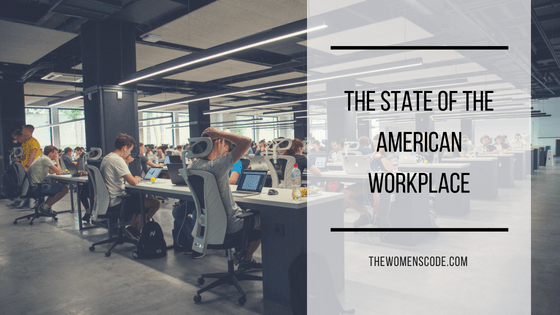The state of the American workplace is best explained in numbers, and these numbers tell a story of the changing demands on our workplaces that have occurred in the past 40 years. According to Gallup’s 2017 State Of The American Workplace study, 67% of Americans are not engaged in their jobs.
Why are the overall numbers for women and men so bad? For answers, let’s look at the men’s code, the women’s code, and the organizational code and how it all ties together.
The men’s code is under fire
The influx of women into every profession, club, society, or workplace requires an evolution that men themselves are bitterly divided about. There are those who say they support equality and believe we need to do a lot more, while others believe women have asked for too much and are responsible for the destruction of traditional family values. As one person commented on my YouTube channel, “Instead of women trying to compete with men, women should return to compliment men like God intended it.”
Men were once the primary income earners and solely responsible for financially supporting his family. But this definition of being a man has all but vanished. Today, supporting a family with a single income seems to be the privilege of the wealthy.
Since the rise of women during the first wave of feminism, the men’s code that has existed for thousands of years is under siege and is crumbling. Women are unstoppable and as it’s predicted that the future is female.
The women’s code is on the rise
Data show women’s insatiable desire to reach equality, and we have made significant advances. On May 31, 2017 the SBA Office of Advocacy shared an Issue Brief that stated, “Women make up more than 50% of the U.S. population, and they have grown to be 47% of the workforce. They have surpassed men in educational attainment, with over 33% of women having a bachelor’s degree or higher. Women control $14 trillion, or 51%, of U.S. personal wealth and are now the primary source of income in over 40% of households.”
But women still only make 80 cents on every one dollar earned by men. Atentry-level positions, women and men fill roles equally at a 50-50% rate. At management level, men’s careers take off and women’s careers stall or fall behind. Men occupy 73% of management positions and 97% of CEO positions.
An additional hurdle of being a working woman is identified by the U.S. Equal Employment Opportunity Commission. In June 2016, this commission reported that 45% of all alleged harassment is on the basis of sex, and anywhere from 25% to 85% of women report having experienced sexual harassment in the workplace (I recently wrote an article about workplace sexual harassment and how easily women and men misinterpret the signals.)
Women who are primary caregivers at home have a lot to manage, especially when considering 70% of mothers with children under age 18 work outside the home and contribute 40.9% of the overall household income (U.S. Department of Labor 2017).
Almost all single women and women without children are a part of the American workforce. Despite challenges and pushback, the rise of women seems unstoppable.
The organizational code is challenged
Study after study proves that more women mean better profits. Just one woman on a board of directors in a financial institution can increase the ROI on investments by up to 66% says Catalyst. We have learned that team intelligence is highest in gender-equal teams. TheInstitute for Women’s Policy Research reports, “if women in the United States received equal pay with comparable men, poverty for working women would be reduced by half and the U.S. economy would have added $512.6 billion in wage and salary income (equivalent to 2.8 percent of 2016 GDP) to its economy.” All this to say that when the American workforce finally represents America’s gender balance, businesses will do really well.
The data show a compelling image of just how good women are for business. So that means it is a good thing women are willing to take on the double duties of motherhood and employment.
Then what is the problem with the American workplace?
In short, it is operating on an old code that was written by men for men, and it simply cannot fit women. We need a system update.
This old system was never designed with women in mind. No matter how many women we feed into the system, or the number who push against it, the cement wall of the men’s code doesn’t break. The old code is deeply embedded into the DNA of our societies. Many men, and quite a few women, want to uphold these proven old traditional values. We’re having a hard time letting go because there is no alternative yet with which to replace the old code.
I can’t take it anymore
Unless we make a real change to this code, we will continue the current status quo—but with increasing anger. It’s already happening. We are having the same discussions again and again. The ruling party puts something in place, only to have it reversed after the next election.
The most significant change we are seeing in workplace equality is the rising hostility. There is an I-can’t-take-it-anymoreelement creeping in. Women are taking action against male behavior in huge numbers at tremendous costs for businesses. The volume of harassment lawsuits is exploding and settlement numbers are reaching epic proportions. The weakening pulse of this old code doesn’t work for women, no longer works for men, and it is very costly for organizations.
Finding a solution
We can solve this by implementing The Women’s Code. It is a logical solution for men, an emotionally supportive one for women, and offers tangible and doable actions for organizations to fix the current code. The Women’s Code is the system update the American workplace needs.
At her lowest point, Beate Chelette was $135,000 in debt, a single mother, and forced to leave her home. Only 18 months later, she sold her image licensing business to Bill Gates in a multimillion dollar deal. Chelette is a nationally known ‘gender decoder’ who has appeared in over 60 radio shows, respected speaker, career coach, consummate creative entrepreneur, and author of Happy Woman Happy World. Beate is also the founder of The Women’s Code, a unique guide to women leadership and personal and career success that offers a new code of conduct for today’s business, private, and digital worlds. Determined to build a community of women supporting each other, she took her life-changing formula documented it all in a book Brian Tracy calls “an amazing handbook for every woman who wants health, happiness, love and success!”
Through her corporate initiative “Why Acting Like a Girl Is Good For Business” she helps companies with gender diversification training, and to develop and retain women.
If you’d like to book Beate as a speaker on New Leadership Balance or Creative Entrepreneurship for your next event please connect with me.




